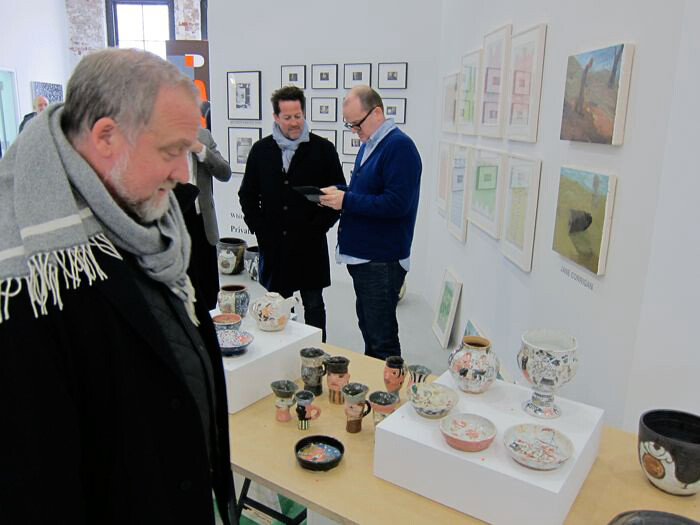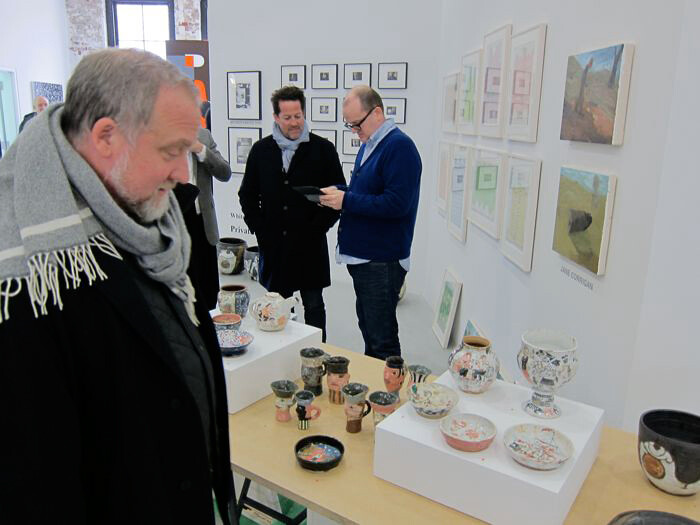In the weeks leading up to this year’s Independent art fair, the self-styled “temporary exhibition forum” that has taken up residence in the former Dia Art Foundation building during each Armory week since 2010, I felt a creeping, empathetic anxiety. How would exhibitors respond to the increasingly crowded field of art fairs with similar indie credentials? Would there be evidence of growing pains, or worse yet, an awkward adolescent phase?
As it turns out, I needn’t have worried. While the funhouse vibe of years past may have subsided (there are no oversized inflatable rats, for example, like the one by the Bruce High Quality Foundation that greeted visitors to Independent’s first iteration), what remains is a casually self-assured, even subdued presentation of works by artists from both within and beyond the mainstream. There’s not much by way of shock value or even spectacle here, though I doubt most visitors will miss the glittery multiples and clever slogans that populate other fairs. Still, with more than 40 galleries and several non-profits and publications spread comfortably among three floors, there is plenty to see and appreciate.
New this year is the Privatus Prize, a 10,000 USD award juried by independent curator Clarissa Dalrymple and Artists Space director Stefan Kalmar. The criterion for the prize is loosely defined as “outstanding curatorial work”—and it is unclear if it is meant to honor a particularly striking booth or a risk-taking program in general. The judges seemed to favor the latter interpretation, splitting the prize evenly among the four non-profit institutions invited to participate in the fair this year: White Columns, Printed Matter, The Kitchen, and the Glasgow International Festival of Visual Art. This gesture of solidarity between non-profit and commercial institutions is just one among many instances of productively blurred boundaries at Independent—right down to the fair’s relatively open floor plan and easy, almost organic flow of circulation.
As for the art, the stellar presentation at White Columns included a wall full of Rocco Fama’s colorful drawings of imagined skyscrapers and a nearby table covered with quirky ceramic vessels by the octogenarian California artist Magdalena Frimkess. Both artists could be considered outsiders; Fama, whose drawings have never been seen in an art context before, was involved with the non-profit cultural access program Hospital Audiences Inc., while Ms. Frimkess is better known for working with her husband, ceramicist Michael Frimkess. With her husband now suffering from the effects of multiple sclerosis, Magdalena Frimkess has begun painting fanciful imagery on some of his decades-old unfired works, alongside her own hand-worked forms.
The allure of outsider status also animates the work shown around the corner at the booth of Galerie Susanne Zander from Cologne. In a cohesive gathering of drawings, photographs, and sound works made by artists acting as spirit-world intermediaries, the portraits by German artist Margarethe Held (1894–1981) stand out. Her pencil and pastel drawings of insect-eyed ghosts, elves, and gods—all apparently executed under the guidance of various spirits, including one who contacted her when she sought to communicate with her dead husband—seem uniquely timeless. Several galleries showed successful artist pairings, though none of the dealers I spoke to would admit to being inspired by the curatorial call-to-arms of the newly established Privatus Prize. At Wilfried Lentz, Doug Ashford’s semi-abstract paintings—informed by archival photographs of Vietnam War protests—are juxtaposed with James Beckett’s recessed dioramas combining photographs of the author and environmental activist Rachel Carson with molecular models of the chemical pesticide DDT. Both artists use elements of high modernist design and documents from 1960s political activism to reactivate certain utopian attitudes. Stopping by Herald St, I was convinced that the match-up of Oliver Payne’s humorous paintings of climbing holds (abstract, yes, and sometimes even monochrome) with Nicole Wermers’s craggy conglomerates of dishware in drying racks pointed to a mountaineering theme, but the puzzled looks I got when I mentioned my theory suggested I had gotten a bit carried away.
The (unofficial) prize for the sexiest booth, meanwhile, goes to Gavin Brown’s enterprise, where Kerstin Brätsch was teamed up with Thomas Bayrle—think luscious but cheeky stained glass panels, set in a whirlwind of clothes cast aside and endlessly replicating cartoon penises. At the center of this installation is Brätsch’s readymade “mini moon”: a high-powered Japanese lamp meant for nighttime construction work. The installation by International Art Objects Galleries was several degrees mellower, but still very seductive somehow, with Billy Childish’s moody, gestural oil paintings (surprising) shown alongside a set of laser-engraved pastel-colored panels by Pae White (charming), and several photorealistic, painted blow-ups of paper collages by Kim Fisher (beautiful).
Independent is also host to a handful of exciting debuts this year. Jack Lavender is a recent graduate of London’s Royal College of Art and showing in New York for the first time. His solo presentation at The Approach includes three-dimensional collages formed from bent and welded metal and hanging sculptures made from chains, hooks, and desiccated textiles. These formal experiments are punctuated with the detritus of a stoner-sensibility and convenience-store lifestyle—salty snack wrappers, energy drinks, oversized click lighters, and cardboard air fresheners. Meanwhile, Stuart Shave/Modern Art has devoted its booth to twenty-five-year-old Anna-Bella Papp, a Transylvania-born artist now living in Amsterdam. This is her first solo exhibition anywhere, ever, and it’s really stunning work. Papp makes smooth, spare reliefs in unfired clay—some with Fontana-like slashes, others with esoteric, geometric shapes, and still more with figurative elements (including a stylized cat clutching a wine bottle).
One of the best booths at this year’s Independent was new to the New York scene, the Antwerp gallery Office Baroque. There’s something satisfying about seeing such a diverse group of works all together: Owen Land’s vintage 16mm film vs. Michel Auder utterly new video (made from high-definition footage and stills captured with his iPhone); Tamar Halpern’s painterly abuse of toner ink vs. Neil Cambell’s more minimal acrylic wall painting made for an obtuse corner of the booth. Lastly there is Leigh Ledare’s An Invitation (2012), a pair of erotic photographs collaged with the front pages of the New York Times from the day the pictures were taken. As with most of Ledare’s work, it is the backstory of the relationships involved that gives the work its edge; here the identity of the woman depicted has been redacted and yet enough details remain for vivid interpersonal narratives to develop. If any new trends are apparent among the works at Independent, most prominent is probably a tendency toward what might be called post-human surrealism. It’s clear in the digital smudge of works by Alex Dordoy on view at the Modern Institute—his Milk and silk (2012) includes several poignant versions of an image of the South African runner Caster Semenya, all reworked in inkjet toner and oil paint on appendage-like plaster forms. This kind of contingency is also seen in photographs by Lucie Stahl (co-presented by Gió Marconi, Milan, and Neue Alte Brücke, Frankfurt), which start out as simple political and pop culture collages but end up quite mind-bending after having been scanned while in the grasp of the artist’s hands. A third artist working in this vein is Alisa Baremboym, whose silk chiffon and ceramic sculptures are graceful but vaguely menacing. Presented by 47 Canal, her works defy easy photographic documentation, making them worth the visit to see in person. As a whole, the blurry, holographic nature of works like these cut to the quick—they are a physical reminder that such virtuality is increasingly our only reality.
But in the end, a fair is a fair is a fair—even Independent, which aims for shifting boundaries and transparency at every turn. Another kind of surrealism (the honest kind) revealed itself as I prepared to leave the show on Thursday. With the preview over, the opening reception was in full swing, and the proprietors of Broadway 1602 were recruiting prospective gamblers for a friendly round of blackjack. The game was part of a presentation of Artcash, a project developed by Experiments in Art and Technology (E.A.T., which was founded by Robert Rauschenberg and Robert Whitman, among others) in 1971 as a benefit for artists working in experimental public television. Artists designed their own “cash,” but other people gambled with it—a speculative activity meant to sustain an entire ecosystem of creative output. My, my, how things haven’t changed.










